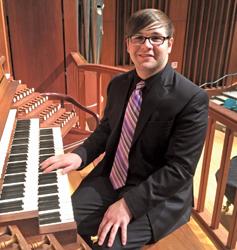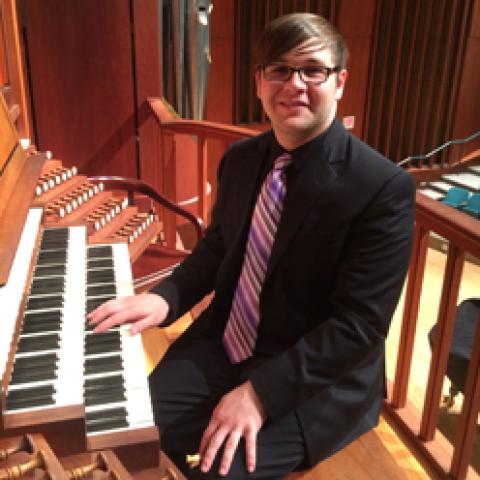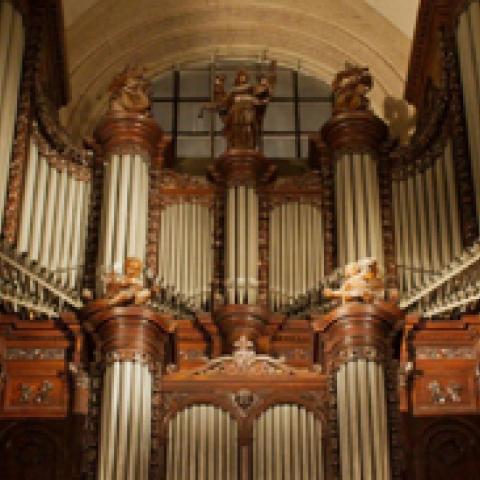British Organ Music Seminar
July 25–29, 2013
The ninth British Organ Music Seminar was held for four days in London, beginning on July 25. The seminar began with a train ride to Cambridge to visit the chapel of Emmanuel College, with its three-manual 1988 Kenneth Jones tracker instrument, which used the case and some of the pipework of the original Father Smith instrument of 1688. Colin Walsh, organist laureate of Lincoln Cathedral and a visiting organ teacher at the University of Cambridge, was our host. He conducted a workshop on liturgical improvisation with several reluctant volunteers followed by a session of various British organ works, performed by members of the group.
On July 26, we visited the French Church of Notre Dame de France, where we attended classes all day. The church, which serves a large French population in London, is located near Leicester Square and dates back to 1861. The organ was originally built by August Gern, who had worked with Cavaillé-Coll. It has undergone several rebuilds, most recently by B. C. Shepherd & Son in 1986. Duncan Middleton, the organiste titulaire at the church since 1989, had studied liturgical and concert improvisation in Bordeaux and Lourdes; he led us in the opening session on improvisation. In the next masterclass, participants played British organ works with John Hosking, assistant organist of St. Asaph Cathedral in Wales. In the afternoon session, Dame Gillian Weir conducted an exciting masterclass on French and German works, played by members of our group. Later in the day we attended Evensong at Westminster Abbey, which was sung by a visiting choir from Breda Cathedral in the Netherlands. Following the service, Peter Holder, organ scholar of the Abbey, talked to the group about the history of the organ and gave a demonstration of the stops. The organ was originally built in 1727 by Schrider & Jordan, with several rebuilds by William Hill in the 19th century and most recently by Harrison & Harrison. Afterwards, participants were given the chance to play the instrument.
We then went across the street to Central Methodist Hall. The organ, with its imposing 32-foot façade, was built by Hill & Son in 1912 and was later rebuilt by Rushworth & Dreaper in 1970. A major rebuild by Harrison & Harrison in 2011 was based on the original Hill scheme. Gerard Brooks, the director of music, is associated with French repertoire and has recorded the complete works of Gigout. His class for the evening was on the organ works of Gigout (other than the well-known Dix Pièces), along with works of Saint-Saëns.
On July 27, we traveled to Peterborough Cathedral to play one of the finest William Hill organs in the country. Built in 1894, Hill, one of the two most celebrated organ builders of the nineteenth century, incorporated the existing pipework in his four-manual organ masterpiece of 86 stops. Its last restoration took place after a fire in 2001. Like other Hill instruments of this period, the organ is set considerably sharper than modern concert pitch. David Humphreys, assistant director of music of the cathedral, gave a brilliant demonstration, after which participants had ample playing time on the instrument. In the afternoon, we traveled to Cambridge for some free time, shopping in the local music store, and having afternoon tea. In the evening we attended Evensong at Ely Cathedral, followed by a demonstration of the organ by assistant organist Jonathan Lilley. The organ was first built in 1685 by Renatus Harris. Elliot and Hill installed a new organ with existing pipework in 1831, with William Hill doing restoration work in 1850. In 1908, Harrison & Harrison built a mostly new organ, using pipework from the previous instruments, with a restoration in 1974–1975 supervised by Arthur Wills, who was then the cathedral organist.
The final day of the seminar was Sunday, so participants attended services at various churches, including St. Paul’s Cathedral. In the afternoon we visited All Soul’s Langham Place, which is a familiar landmark at the end of Regent Street. In 1913, Alfred Hunter installed a new instrument in this church, replacing the original organ built by Bishop in 1824. This Hunter instrument was rebuilt and enlarged by Henry Willis III in 1951, with the most recent restoration by Harrison & Harrison in 1976. Gerard Brooks conducted a masterclass, played by the members of our group. Later in the afternoon, participants could attend recitals at St. Paul’s Cathedral, Westminster Abbey, or Westminster Cathedral. The seminar ended with a visit to Westminster Cathedral, just down the street from the abbey. It contains the Apse Organ built by T. C. Lewis prior to World War I and the Grand Organ, which is one of the two heroic instruments built by Henry Willis III, the other being the Liverpool Anglican Cathedral. Peter Stevens, the assistant master of music, talked about the history of the instrument, gave a fine demonstration of the organ, and assisted participants as they played this magnificent instrument, which made a spectacular end to an eventful seminar.
—Cliff Varnon
French Organ Music Seminar
July 29–August 7, 2013
“If you listen, you will learn.”
—Thomas LaCôte, La Trinité, Paris
Organ builder Aristide Cavaillé-Coll listened to the sounds in his head before he started building the romantic organ. Louis Robilliard of Lyon told us that if there had been no Cavaillé-Coll, there would be no romantic organ music.
When Widor sat at the Cavaillé-Coll, he listened, and came up with ideas for his symphonies. Vierne and Guilmant listened and did the same. A stunning reminder to the organist: the dream organ came before the compositions. Here’s a dream: to travel back in time, attend a concert at the Palais du Trocadéro, and listen to the now-extinct Cavaillé-Coll as Widor conducts his Third Symphony with Vierne at the organ!
Thanks and appreciation are due to Christina Harmon, Dallas organist, teacher, and composer who led this group of American organists. Through her well-established FOMS program, we are privileged to experience the French tradition. Additional indispensable co-directors this year were Cliff Varnon and Masako Gaskin. All three worked hard to keep this group of organists, organ students, and organ lovers happy and informed. For more information and notice of future events, see www.bfoms.com.
Participants varied from virtuosos with ever-expanding organ repertoire to lifelong students who treasure their favorite pieces and still look for interpretation ideas from close connections to the source. In addition to masterclasses, there were classes in improvisation and ample opportunities for private lessons. Our youngest organist was 15 and the oldest 83!
How fortunate for this group that there are still essentially unaltered romantic organs in existence that we are able to touch and play. The first on this trip was the Cavaillé-Coll in Lyon at St. Francois de Sales, the Widor family parish, where Charles-Marie was baptized and later first performed Symphony V.
July 29–30: Lyon and Chambéry
The perfect warm-up act to the frenzied pace of Paris was the time spent in Lyon and the Alps, organized by the organist of Chambéry Cathedral, Thibaut Duret, with the help of François Espinasse, professor of organ at the National Conservatory of Lyon. Françoise Webb, the charming French native who spent her youth in Reims, assisted with the preparations and organization. Our first day was spent with Louis Robilliard at the great Cavaillé-Coll organ of Saint-François-de-Sales. Built in 1880, it was restored in 1964 and is still in its original and unaltered state.
Time spent with François Espinasse and Thibaut Duret and two concerts on the marvelous 1847 Augustin Zeiger organ at Chambéry Cathedral allowed each of us a performance turn, followed by a third inspiring performance by our regional host Thibaut Duret. Duret is a brilliant young organist and improviser who studied with François Henry Houbart at Rueil Malmaison and with François Espinasse and Loïc Mallié at the Lyon Conservatoire, where he received a master’s degree in organ. With the Alps as backdrop, we spent Wednesday and Thursday playing the organs in St. Pierre d’Albigny, Manigod, Thônes, Grand Bornand, and Annecy. Each organ had a particular charm, and more information is available about each of them on the FOMS website (www.bfoms.com).
August 2: Dole and Dijon
On Thursday, after a 2½-hour bus ride, we arrived in Dijon. While there we played the much-restored Daublaine-Callinet organ at the Cathèdrale St. Bénigne in Dole and the particular highlight: the untouched, undusted, very much in tune 1754 Karl Riepp organ at the Collégiale Notre Dame de Dole. With a Louis XV oak case, this was the largest organ in provincial France, with 45 stops over four manuals and pedal and a 32′ Montre in the Grand-Orgue. In 1860 the 32′ Montre was moved to the pedal and in a 20th-century renovation it made its way back to the Grand-Orgue, the organ now being five manuals with 73 stops. One room on the way to the organ gallery housed a museum that traced its fascinating history.
August 3: Reims
By Saturday, August 3, we were in Reims, where we played the Cathédral Notre-Dame de Reims organ. Unfortunately, on our way that morning we received a call from Benjamin Steens, our excellent host in Reims, who told us a fire had broken out in the organ of St-Remi (Cattiaux, 2000), where we were to spend the afternoon. A visit to the famous champagne caves helped us to cope with our disappointment at not being able to play at the basilica.
August 4–7: Paris
In Paris we visited the always-amazing organ at St. Sulpice (suffering from the unusual heat of Paris in August), as well as the Cavaillé-Coll of Notre-Dame des Champs, Aristide Cavaillé-Coll’s own parish, built in 1877. This organ was extensively altered by Schwenkedel, although, fortunately, the Barker action was retained. Thanks to Cavaillé-Coll, who was on the building committee for the church, also built in 1877, the acoustics for the organ are some of the best in Paris.
At Notre-Dame des Champs, we had stimulating masterclasses with Sophie-Véronique Cauchefer-Choplin, Beatrice Piertot, and Yannick Merlin. In the masterclass with Dupré expert Cauchefer-Choplin, three participants enabled us to delve into segments of the Symphonie-Passion, the composer’s Wanamaker improvisation that he later wrote down after returning to France. Cauchefer-Choplin said Dupré loved the sound of the gambe alone because it was mysterious.
Stimulating duo-organ performances and masterclasses by upcoming organists Beatrice Piertot and Yannick Merlin also took place at this church during the week in Paris. These two brilliant young organists also helped in this year’s planning and gave classes at the beautiful, unaltered Merklin organ at the church of St. Laurent.
Daniel Roth entertained and enlightened us at St-Sulpice with historical anecdotes about the organ and stories of Franck, Widor, and Dupré that organists never tire of hearing. Cavaillé-Coll kept more than 40% of the 1781 Clicquot organ pipework, never intending to make an exclusive change to a romantic organ. In fact, Widor’s colleague Albert Schweitzer said the organ was great for baroque music. Roth clarified that the transition from Baroque to Romantic was abrupt in Germany, whereas in France, it was gradual. To see more of Roth’s mesmerizing history of French organ music and organs, you can find numerous DVDs of Roth’s St-Sulpice lectures and performances on YouTube, all produced by Christina Harmon. Better still, break down and buy the DVDs from the Organ Historical Society!
It still takes my breath away to sit in the loft with Olivier Latry at Notre Dame during Mass. His playing for four Sunday services allowed all 29 organists and students a chance to be at the organ, complete with a console containing the latest organ technology and design.
Classes and playing time were offered by Thomas LaCôte at La Trinité (the organ of Messiaen), at Sainte-Clotilde with Nicolas Pichon, La Madeleine, with Andy Dewar at the American Cathedral, and at Notre Dame d’Auteil with Frédéric Blanc (living conduit to the music of Duruflé). LaCôte told us Messiaen liked the sound of ice and crystal, 16′ & 2′ (Messe de la Pentecôte).
Blanc told us that Duruflé was not a man for big chords, but rather the musical line. He favored flutes and celestes. He also told us that the famous story of Duruflé not liking his Toccata was not necessarily true, but that at the time he was very tired and had composed this piece during a very stressful period in his life.
Our last day was spent with Jean-Baptiste Robin in Versailles and included a concert by him on the Clicquot organ (modified by Cavaillé-Coll) at the Versailles Cathedral, a masterclass at the church of Notre Dame des Armées of Versailles, and playing at the Royal Chapel organ of Versailles Palace. The palace organ was originally built by Robert Clicquot in 1710. After severe damage during the French Revolution it was rebuilt as a two-manual organ by Cavaillé-Coll in 1873. In 1936 it was sold to the seminary in Châteaugiron and later to St. Martin Church in Rennes, where a reconstruction was attempted by Victor Gonzalez. In 1995 a completely new instrument was made by the firms of Boisseau and Cattiaux, which not only reconstructed Robert Clicquot’s creation but also reconstructed the additions of Louis-Alexander and Francois-Henry Clicquot as well. This result was amazingly successful and stands today in the Royal Versailles Chapel as a proud tribute to Clicquot’s genius.
As a protégé of Marie-Claire Alain, Jean-Baptiste Robin gave an intense class on Jehan Alain. Robin told us that after the trauma of World War I, artists turned to the past, and Alain was the first to go to early music, layering it with orientalism and with jazz that had been brought by Americans during the war. Alain was fascinated by the cornet, a sonority he explored extensively. Tutti, or massive sound, is seldom found in Alain’s music. Our day ended with palace organist Robin demonstrating French Classical music on the beautiful chapel organ of the palace. Participants were actually able to play the chapel organ! Robin is one of four titular organists. The others are Michel Bouvard, François Espinasse, and Frédéric Desenclos, with Michel Chapuis serving as honorary titulaire.
To be in France and therefore in the center of the vital and enduring influence of the world’s greatest organ tradition is as fascinating and transforming as ever. The spirits of Widor, Vierne, Messiaen, et al. continue to permeate the sensibilities and ethos of this beautiful part of the world through the brilliant French artists of the present. There is no more amazing experience, or better pilgrimage, for an organist. Teach us to listen, and learn…
—Helen VanAbbema Rodgers




